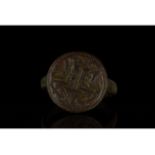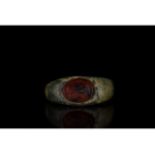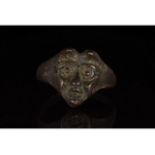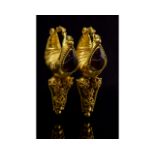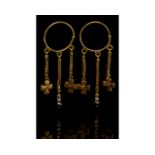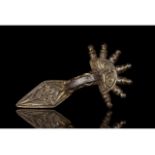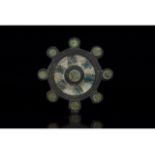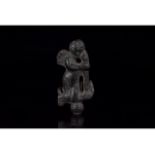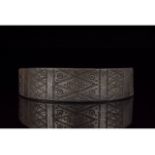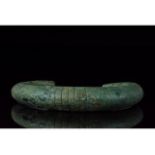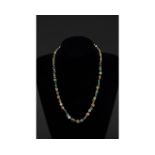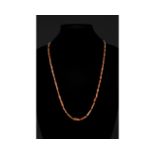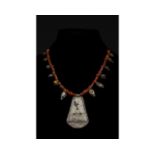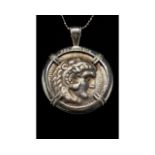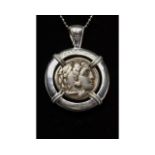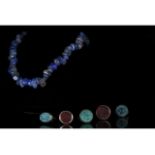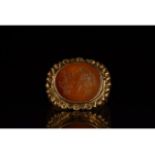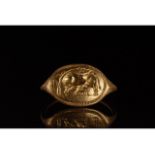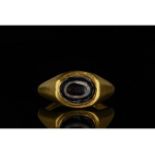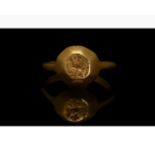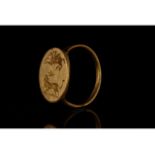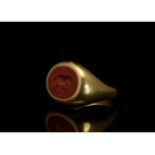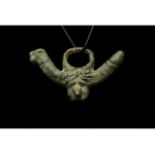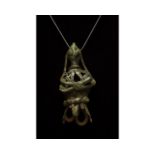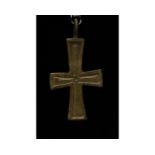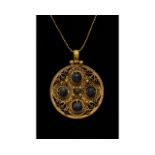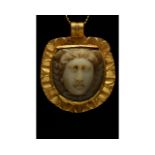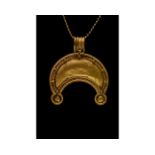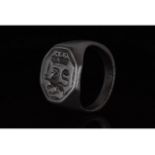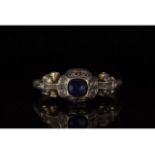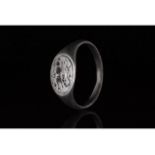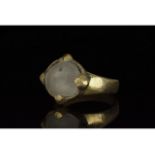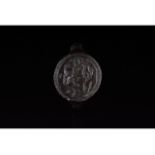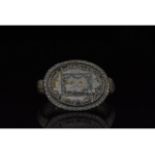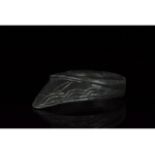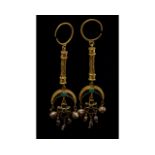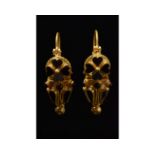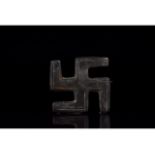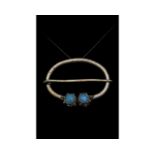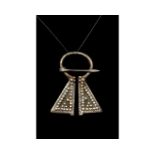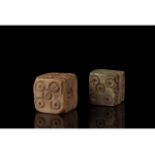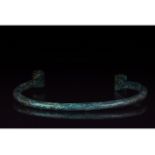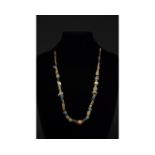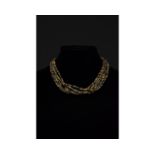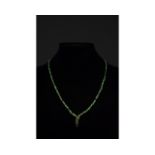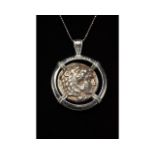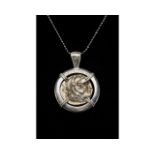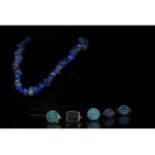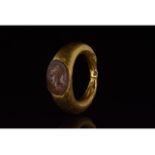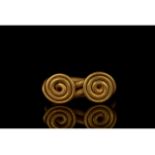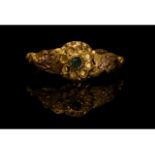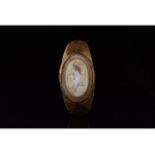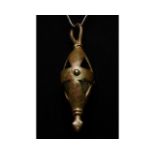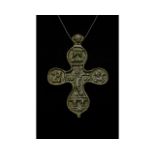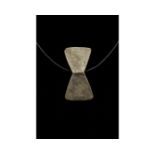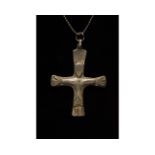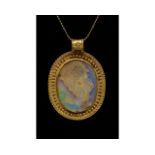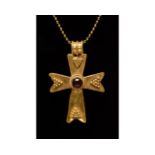Refine your search
Estimate
Category
- Arms, Armour & Militaria (180)
- Jewellery (118)
- Greek, Roman, Egyptian & Other Antiquities (86)
- Chinese Works of Art (55)
- Scientific Instruments (33)
- Sculpture (24)
- Collectables (20)
- Coins (19)
- Ceramics (13)
- Salvage & Architectural Antiques (8)
- Vintage Fashion (8)
- Glassware (7)
- Bank notes (6)
- Islamic Works of Art (6)
- Metalware (6)
- Books & Periodicals (5)
- Models, Toys, Dolls & Games (3)
- Textiles (3)
- Classic Cars, Motorcycles & Automobilia (2)
- Musical Instruments & Memorabilia (2)
- Wines & Spirits (2)
- Clocks (1)
- Kitchenalia (1)
- Silver & Silver-plated items (1)
Filtered by:
- Item Type
- List
- Grid
A subscription to the Price Guide is required to view results for auctions ten days or older. Click here for more information
1100-1300 AD, Medieval. Ring with D-shaped hoop and flattened, round bezel featuring incised decorationof two facing dragons. Dragons are an impor...
100-300 AD, Roman. Bronze ring with a D-Shaped hoop, and an oval-shaped red intaglio with 'dextrarum iunctio' ('joining together of the right hand...
C. 1500-1700 AD. Post-medieval. A rare silver ring with a circular hoop and applied bezel in the form of a devil’s head, with beaklike mouth, ci...
c. 323-31 BC. Greek Hellenistic period. A stunning pair of large gold earrings comprising a large boat-like hoop with a drop-shaped garnet cabocho...
1100-1300 AD. Byzantine. A pair of stunning gold hoop earrings, each with three chain pendants arranged in a row; the two outer pendants terminate...
500-600 AD. Gothic. Silver gilt radiate bow brooch, with semi-circular head featuring seven radiating knobs; the head is connected by an arched bo...
100-200 AD. Roman. A bronze disk-shaped brooch comprising a central boss surrounded by a wheel design in a blue and white millefiori glass composi...
ROMAN BRONZE CUPID BROOCH
100-200 AD. Roman. A cast bronze brooch in the form of Cupid. He is depicted as a winged child in flight, holding his characteristic bow. The pin ...
700-900 AD, Viking Age. A heavy silver bracelet with areas of incised decoration in the form of bands of lozenges and dots, perhaps designed to im...
1000 – 600 BC, Bronze Age. This thick and heavy cast bronze bracelet features a wide band with a D-shaped section and incied linear decoration. ...
Ca. 100-300 AD. Roman. A restrung necklace of Roman millefiori glass beads of spherical and cylindrical form and made using a wide range of colour...
Ca. 100-300 AD. Roman. A restrung necklace of beautiful tubular semi-precious carnelian beads spacced by small, round metallic beads. This necklac...
AD 900-1100. Viking Age. An elegant necklace comprised of carnelian beads of various shapes (spheres, cylinders and barrels) and small silver pend...
C. 295-275 BC. Hellenistic Period. A silver tetradrachm coin of Alexander the Great within a modern handmade circular sterling silver setting made...
C. 295-275 BC. Hellenistic Period. A silver drachm coin of Alexander the Great within a modern handmade circular sterling silver setting made excl...
Ca.1700-1950 AD. Yemeni Tribal. Lot of five white metal Yemeni Tribal intaglio rings with turquoise and red coloured stone itaglio settings some w...
100-300 AD. A solid gold ring with a circular hoop with scalloped edges and shoulders and an oval-shaped orange carnelian intaglio bearing a snake...
100-300 AD. Roman. Gold ring with a D-shaped hoop and bulging elliptical plate bearing an engraved depiction of a cow and her calf below the bow o...
ROMAN GOLD "EYE" RING
100-300 AD. Roman. Gold ring comprising a bow-shaped hoop with sloping shoulders and elliptical black glass “eye†setting with grey details. Th...
CA. 600 AD. BYZANTINE GOLD RING WITH BIRD AND CROSS. In order to confirm its authenticity, this piece has undergone X-Ray Fluorescence analysis by...
C. 100 AD, Roman. Well-preserved Gold ring with circular hoop and flattend round bezel featuring and engraved lion and gryphon motif. This item ma...
CA. 100 AD. ROMAN SOLID GOLD INTAGLIO RING WITH BULL . In order to confirm its authenticity, this piece has undergone X-Ray Fluorescence analysis ...
ROMAN BRONZE PHALLUS PENDANT
c. 100-300 AD. Roman. A spectacular bronze pendant comprising a phallus and closed fist joined by a smaller phallus and pair of testes. The piece ...
c. 2000-1000 BC, Amlash culture. An openwork bronze fertility pendant comprising a female bust with a child. She is depicted in the round, with lo...
CRUSADERS ERA BRONZE CROSS
1000-1500 AD, Crusader Period. Bronze cross pendent with suspension loop. Engraved detail on the obverse depicts a smaller cross centered on a sma...
C. 1100-1300 AD. Byzantine. A stunning gold disk pendant bearing an openwork floral cross motif ornamented with garnets, as well as other black an...
100-300 AD. Roman, A gold pendant with a rounded suspension loop, truncated drop-shaped body with petalled border and milky white cameo stone in h...
ROMAN GOLD LUNAR PENDANT
Ca. 100 AD, Roman. Gold lunar amulet comprises a crescent moon with suspension loop, corded border and applied spheres. In Roman mythology, Luna (...
1100-1300 AD, Medieval. Bronze ring with D-shaped hoop and flattened, octagonal bezel featuring incised decorationdepicting a lion holding a sword...
1400 AD. Late Medieval. A superb silver gold ring with a fine circular hoop, spiral-shaped moulded ornamentation on the shoulders and a rosette-sh...
c. 1000-1100 AD. Viking age. A beautiful silver ring with a D-shaped hoop and an elliptical bezel bearing incised decoration in the form of a hunt...
700-1100 AD, Viking Age. Silver gilt ring with a circular hoop, and a lozenge shaped bezel onto which is mounted a large, circular clear gem. This...
1100-1300 AD. Medieval. Bronze ring with D-shaped hoop and flattened, circular bezel featuring incised decoration depicting a a wolf and a dragon....
100-300 AD. Roman. A silvered bronze ring with a D-shaped hoop and elliptical plate bezel bearing an engraved border of semicircles which frame a ...
MEDIEVAL BRONZE ARCHERS RING
C. 1000-1500 AD. Crusader period. A bronze archer’s ring comprising a circular hoop and projecting triangular guard bearing an engraved floral m...
C. 1100-1300 AD. Byzantine. A stunning pair of elaborate gold earrings comprising an open, circular hoop, elongated woven cord connected to a cres...
c. 323-31 BC. Greek Hellenistic period. A stunning pair of gold hoop earrings each with an applied frontal stud bearing inlaid heart-shaped garnet...
c. 100-300 AD. Roman. Bronze openwork swastika brooch with well-preserved catch-plate on the reverse and surviving pin. The swastika was a symbol ...
Ca. 700- 1100 AD. Viking Era. A fine silver Viking era 'Omega' penannular brooch with hemi-spherical blue gems set into the terminals, a circular ...
Ca. 900-1100 AD. Viking Era. A late Viking era silver pannanular omega brooch with flaring terminals decorated with raised dots arranged in geomet...
ROMAN BONE DICE
100-300 AD. Roman. A set of two bone dice with carefully carved dot-in-circle pips which are typical of dice of the Roman period. Games involving ...
1000–600 BC, Bronze Age. This thick and heavy cast bronze bracelet features a wide band with a raised midrib which tapers into recurved and coil...
1000 – 600 BC, Bronze Age. This thick and heavy bronze torc has a simple single strand design, with highly decorative recurved and coiled termin...
Ca. 100-300 AD. Roman. A restrung necklace of Roman beads comprising multiple opaque and transparent sub- spherical, tubular and rectangular glass...
C. 100-300 AD. Romano-Egyptian. A beautiful restrung necklace comprised of multiple strands of disciod faience beads range of colours. Necklace be...
Ca. 100-300 AD. Roman. A restrung necklace of Roman beads comprising multiple opaque and transparent sub- spherical, tubular and rectangular green...
C. 295-275 BC. Hellenistic Period. A silver drachm coin of Alexander the Great within a modern handmade circular sterling silver setting made excl...
C. 295-275 BC. Hellenistic Period. A silver drachm coin of Alexander the Great within a modern handmade circular sterling silver setting made excl...
Ca.1700-1950 AD. Yemeni Tribal. Lot of five white metal Yemeni Tribal intaglio rings with turquoise, blue and turquoise coloured stone itaglio set...
100-300 AD. Roman. Elaborate gold ring with circular hoop, flaring shoulders and elliptical bezel; an oval-shaped red gem setting bears a portrait...
700-1100 AD, Viking Age. A gold coiled ring comprising a circular hoop formed from a strand of gold with coiled terminals and trailings ends which...
CA. 1400 AD MEDIEVAL GOLD RING WITH EMERALD STONE. In order to confirm its authenticity, this piece has undergone X-Ray Fluorescence analysis by a...
C. 100-300 AD. Roman. Gold ring comprising D-shaped hoop and elliptical bezel with a pale setting. The setting bears an engraved male bust with sh...
BRONZE AGE "CAGE" PENDANT
C. 600 BC, Bronze Age. A large bronze cage pendant. The pendant's biconical shape is formed of a single sheet of bronze with small sections remove...
1000-1500 AD, Crusader Period. A large bronze cross pendant with suspension loop and rounded arms; the cross bears extensive relief decoration on ...
VIKING SILVER DOUBLE-AXE AMULET
900-1100 AD, Viking Age. A silver example of a double axe or Perun amulet comprising a suspension loop and a double sided stylised axe head. This ...
1000-1500 AD, Crusader Period. Silver cross pendant with suspension loop and tapering arms featuring a stylised figure of Jesus during his crucifi...
c. 100-200 AD. Roman. An oval-shaped gold pendant with an elegant filigree border and highly patinated glass setting; an integral suspension loop ...
ROMAN GOLD TWO SNAKES PENDANT
c. 100-300 AD. Roman. A gold pendant formed two snakes formed from a coiled gold wire, suspended from a substantial circular suspension loop with ...
1000-1500 AD, Crusader Period. Gold pendant in the form of a Maltese cross with a rounded suspension loop, arms of approximately equal length with...

